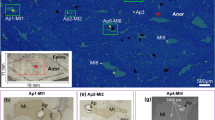Abstract
The free energy data for the simple fluorides, chlorides and hydroxides have been used to predict the distribution of these anions in hydrous minerals. The calculated partition of fluorine in phlogopite agrees well with published results; the distribution of fluorine and hydroxyl between apatite and phlogopite is temperature dependent and has been calculated. The temperatures deduced from analyses of natural apatite-biotite pairs frequently show discrepancies as compared with independent temperature estimates; these probably arise from late-stage exchange of the fluorine in phlogopite with an aqueous fluid, for which independent evidence is available.
The fugacity of phosphorus in equilibrium with apatite, a ubiquitous hydrous mineral, has been calculated for various mineral assemblages. The estimates, which are subject to considerable error, are lower for basanites and alkali-basalts than for tholeiites and range from approximately 10−14 at 1000° C to 10−16 bars at 750° C for fayalitic rhyolites.
Similar content being viewed by others
References
Buddington, A. F., Lindsley, D. H.: Iron-titanium oxide minerals and synthetic equivalents. J. Petrol. 5, 310–357 (1964).
Carmichael, I. S. E.: Trachytes and their feldspar phenocrysts. Mineral. Mag. 34, 107–125 (1965).
—: The iron-titanium oxides of salic volcanic rocks and their associated ferromagnesian silicates. Contr. Mineral. and Petrol. 13, 36–64 (1967 a).
—: The mineralogy and petrology of the volcanic rocks from the Leucite Hills, Wyoming. Contr. Mineral. and Petrol. 15, 24–66 (1967 b).
— Nicholls, J., Smith, A. L.: Silica activity in igneous rocks. Am. Mineralogist 55, 246–263 (1970).
Correns, C. W.: The geochemistry of the halogens. Phys. Chem. Earth 1, 181–234 (1956).
Darken, L. S., Schwerdtfeger, K.: Appendices in Schwerdtfeger, K., and A. Muan: Activities in olivine and pyroxenoid solid solutions of the system Fe-Mg-SiO2at 1150° C. Trans. Aime 236, 201–211 (1966).
Deer, W. A., Howie, R. A., Zussman, J.: Rock forming minerals. 5, New York: Wiley 1962.
Evans, B. W.: Chlorine and fluorine in micas of pelitic schists from the sillimanite-orthoclase isograd, Maine. Am. Mineralogist 54, 1209–1210 (1969).
Gillberg, M.: Halogens and hydroxyl contents of micas and amphiboles in Swedish granitic rocks. Geochim. Cosmochim. Acta 28, 594–516 (1964).
Huang, P. M., Jackson, M. L.: Fluorine determination in rocks and minerals. Am. Mineralogist 52, 1503–1514 (1967).
Kudo, A. M., Weill, D.: An igneous plagioclase thermometer. Contr. Mineral. and Petrol. 25, 5–65 (1970).
Janaf, Thermochemical Tables. Midland, Michigan: The Dow Chemical Co. 1960–1962.
McClellan, G. H., Lehr, J. R.: Crystal chemical investigation of natural apatites. Am. Mineralogist 54, 1374–1391 (1969).
Muñoz, J. L., Eugster, H. P.: Experimental control of fluorine reactions in hydrothermal systems. Am. Mineralogist 54, 943–959 (1969).
Nash, W. P., Wilkinson, J. F. G.: Shonkin Sag Laccolith, Montana. I. Mafic minerals and estimates of temperature, pressure, oxygen fugacity and silica activity. Contr. Mineral. and Petrol. 25, 241–269 (1970).
Peck, D. L., Wright, T. L., Moore, J. G.: Crystallization of tholeiitic basalt in Alae lava lake, Hawaii. Bull. Volcanol. 29, 629–656 (1966).
Robie, R. A., Waldbaum, D. R.: Thermodynamic properties of minerals and related substances at 298° K (25° C) and one atmosphere (1.013 bars) pressure and at higher temperatures. U.S. Geol. Surv. Bull. 1259 (1968).
Searcy, A. W.: Entropy and high temperature physical and chemical processes. Chemical and mechanical behavior of inorganic materials, chapt. 2, p. 15. New York: Wiley 1970.
Stormer, J. C., Carmichael, I. S. E.: The Kudo-Weill geothermometer and porphyritic acid glasses. Contr. Mineral. and Petrol. 28, 306–309 (1970).
—: The free energy of sodalite and the behavior of chloride, fluoride and sulphate in silicate magmas. Am. Mineralogist 56, 292–306 (1971).
Taylor, H. P.: Oxygen isotope geochemistry of igneous rocks. Contr. Mineral. and Petrol. 19, 1–71 (1968).
—, Epstein, S.: Hydrogen-isotope evidence for influx of meteoric groundwater into shallow igneous intrusions. (abs.) Geol. Soc. Am. Spec. Papers 121, 294 (1968).
White, D. E., Waring, G. A.: Volcanic emanations. U.S. Geol. Surv. Prof. Pap. 440-K (1963).
Author information
Authors and Affiliations
Rights and permissions
About this article
Cite this article
Stormer, J.C., Carmichael, I.S.E. Fluorine-hydroxyl exchange in apatite and biotite: A potential igneous geothermometer. Contr. Mineral. and Petrol. 31, 121–131 (1971). https://doi.org/10.1007/BF00373455
Received:
Issue Date:
DOI: https://doi.org/10.1007/BF00373455




